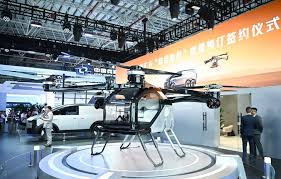China’s automakers soar into low-altitude economy

Henan Daily
Zhengzhou: China’s low-altitude economy is expected to reach 3.5 trillion yuan ($487.5 billion) by 2035, according to the Civil Aviation Administration of China (CAAC).
Attracted by this massive market, Chinese automotive manufacturers are rapidly expanding into the low-altitude economy sector. Several automakers have entered the flight-testing phase of their flying cars.
On June 12, GAC Group made the global debut of its first mass-produced flying car, the GOVY AirCab, and began pre-orders with a recommended retail price of no more than 1.68 million yuan.
The Govy AirCab represents a multi-rotor flying car design, with the upper section functioning as an aircraft and the lower section operating as a conventional vehicle. Its dual-mode system enables both ground-based intelligent driving and aerial flight. It is ideal for short-distance commuting and sightseeing.
XPeng Aeroht, a subsidiary of Chinese electric vehicle maker Xpeng, has developed a “land aircraft carrier,” a flying car that consists of a ground vehicle and an air module. The ground vehicle accommodates four to five passengers and features an extended-range hybrid power system that can recharge the air module. The air module is a fully electric piloted aircraft with vertical takeoff and landing capabilities for low-altitude flight.
These flying cars fall under the category of electric vertical takeoff and landing aircraft (eVTOLs), which represent the mainstream development direction for both domestic and global automakers.
Recently, XPeng Aeroht’s application for a production certificate for its air module was officially accepted by the CAAC Central and Southern Regional Administration. The module is expected to receive type certification by year-end. XPeng Aeroht’s flying car manufacturing facility is scheduled for completion in the third quarter of 2025, with deliveries set to begin in 2026.
The eVTOL developed by Aerofugia, a subsidiary of China’s automotive company Geely Auto, will enter the manned flight-testing phase, and is also expected to obtain its type certificate in 2026.
Meanwhile, the “three-body” composite-wing flying car of Chinese carmaker Chery successfully completed its test flight, and another industry player Changan Automobile announced a partnership with Chinese intelligent aircraft company EHang to advance flying car development and commercialization.
Chinese automakers are eyeing the low-altitude economy due to its enormous market potential. According to the China Low Altitude Economy Alliance, China’s eVTOL fleet is forecast to exceed 100,000 units by 2030.
New energy low-altitude aircraft are core carriers of the low-altitude economy and demonstrate significant technological synergy with intelligent connected new energy vehicles (NEVs), said An Tiecheng, chairman of China Automotive Technology and Research Center Co., Ltd.
An noted that low-altitude aircraft and intelligent NEVs mutually reinforce each other across research and development (R&D) systems, manufacturing, and application scenarios, providing practical pathways for deep integration between these two emerging industries.
Policy support has also been a crucial driver for automakers’ transformation. In 2021, China unveiled guidelines on developing comprehensive transport network, including the low-altitude economy in national planning for the first time.
An outline issued in 2023 and an implementation plan in 2024 further promoted R&D, verification, and commercial applications of flying cars.
This year’s government work report emphasized promoting the safe and orderly development of commercial space, the low-altitude economy, and other emerging industries.
Several local governments have rolled out policies covering infrastructure development, expansion of application scenarios, and supply chain cultivation to support rapid development of the low-altitude economy.
Market response has reflected strong consumer interest and industry confidence. XPeng Aeroht’s “land aircraft carrier” has received over 4,000 pre-orders and secured partnerships with over 200 camps to launch joint operation models for flight experiences, services, and pilot training.
In late 2024, Aerofugia signed an intended purchase agreement with ICBC Leasing for 120 AE200 aircraft—China’s largest single eVTOL order in the financial leasing sector.
An emphasized that the low-altitude economy, as a strategic emerging industry, calls for disruptive innovation. He highlighted the need to integrate technologies such as artificial intelligence and green energy with low-altitude aircraft, and to boost R&D in lightweight materials, electronic sensing, and intelligent driving and control systems.





